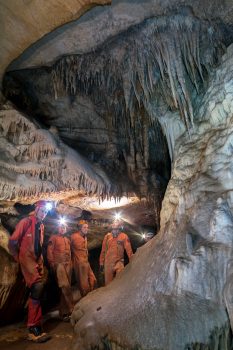Are caves ideal places to find the impossible?
Most science is produced in labs. Chemistry, physics, microbiology, medicine. That’s where you can discover new and exceptional things, study weird and unexplained phenomena or invent your own new material.
It is a little bit harder discover new places or new animals in ordinary labs. You need a new world to be discovered, and on Earth that is not easy. Man has put foot almost on every place on our planet, on almost every mountain top, in any forest. Only some very inhospitable places are still to be explored, such as the icy world of Antartica, or the impenetrable rainforest in Borneo. Or what about diving into the deep abysses of the oceans? Not really easy places to get to, stuff for millionaires. Or you could become an astronaut and wait your turn to explore faraway planets.
But what if you don’t have money, time and patience. Just go and explore caves! The underground is still full of places to be explored, sometimes even at only a couple of feet away from the roads, or even in your back garden. Cavers are the most productive geographic explorers of our contemporary world, finding kilometres of new passages in which no human has ever set foot. And scientists can easily find new animals or microscopic life forms in these remote places of Earth. But not many scientists are able to explore the underground world.
Caves are great places to perform science: they inspire you! Complete darkness, an alien world and strange phenomena to be explained. I started exploring for curiosity, adventure. But the mysteries of caves soon led me to unlock its secrets, performing experiments, sampling materials and living creatures, and allowed me to get some exceptional results. And I am lucky to have become a cave scientist, a Sherlock Holmes of the dark underground. With still many secrets to solve.
Jo De Waele
Watch this video of Jo de Waele on CAVES 2014 science:



Discussion: no comments